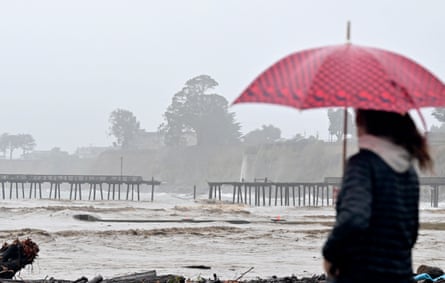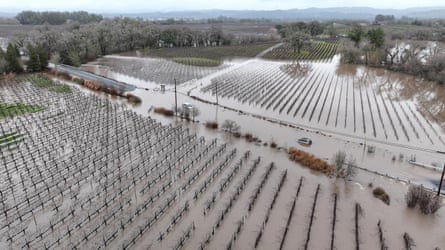A series of deadly and destructive storms continued to hammer California on Monday, as the drought-stricken state grapples with the sudden onslaught of a very wet January.
Joe Biden issued an emergency declaration for California on Sunday, unlocking federal aid to support recovery as mud slides, engorged rivers and streams, and wind-strewn trees wreaked havoc on already-inundated infrastructure across the state. The California department of water resources warned that more than a dozen places were at high risk of flooding.
In southern California, the entire community of Montecito were ordered to evacuate on Monday, amid a deluge of rain that has flooded roads and swollen waterways.
The evacuation order affecting about 10,000 people came on the fifth anniversary of a mudslide that killed 23 people and destroyed more than 100 homes in the coastal enclave, including Oprah Winfrey’s.
Montecito is home to celebrities such as Winfrey, Rob Lowe, and the Duke and Duchess of Sussex. Ellen Degeneres, who also lives there, posted a video on Twitter standing in front of a raging creek on her property, saying she had been asked to shelter in place.
Montecito is under mandatory evacuation. We are on higher ground so they asked us to shelter in place. Please stay safe everyone. pic.twitter.com/7dv5wfNSzG
— Ellen DeGeneres (@EllenDeGeneres) January 9, 2023The Montecito fire chief, Kevin Taylor, said at least 8in of rain had fallen in 12 hours, with several more inches expected. The canyon communities under evacuation orders are at the foot of hillsides burned bare in recent years by wildfires.
The Santa Barbara county sheriff, Bill Brown, said the decision to evacuate came “based on the continuing high rate of rainfall with no indication that that is going to change before nightfall”.
Tens of thousands of people remained without power, and some schools closed for the day. The number of deaths related to the storms climbed from 12 to 14 on Monday, state officials said.
Rescuers in Paso Robles had to call off a search for a five-year-old boy who was swept away by floodwaters in central coastal California. The search for the boy, who has not been declared dead, was called off around 3 pm because the current and rising water levels of the Salinas River were too dangerous for divers, said spokesperson Tony Cipolla of the San Luis Obispo county sheriff’s office.
The boy’s mother was driving a white truck when it became stranded in floodwaters just before 8am near Paso Robles, according to Tom Swanson, assistant chief of the CalFire/San Luis Obispo county fire department.
Bystanders were able to pull the mother out of the truck, but the boy was carried out of the vehicle and swept downstream, Swanson said. There was no evacuation order in the area at the time. A firefighter discovered one of the boy’s shoes, but crews still had not found the child more than five hours later.
The state’s governor, Gavin Newsom, issued a statement urging residents to practice safety. “We are in the middle of a deadly barrage of winter storms – and California is using every resource at its disposal to protect lives and limit damage,” he said. “We are taking the threat from these storms seriously and want to make sure that Californians stay vigilant as more storms head our way.”

Storm-weary residents are facing another bout of heavy downpours, high winds and flooding this week, with two major new storms expected to drop heavy rainfall on the coast and snow in the mountains in the coming days.
Relentless rainstorms over the last 10 days have already killed 12 people, toppled trees and flooded roads, and left thousands of homes and businesses without power. Roughly 139,000 were without power by Monday morning, according to PowerOutage.us, an organization that tracks outages live.
Most of California’s 39 million residents could expect heavy rainfall of up to 5in (13cm) near the coast, more than a foot of snow to the west and wind gusts reaching 65mph across the state, the National Weather Service said.
California’s governor, Gavin Newsom, said 12 people died as a result of violent weather during the last 10 days, and he warned that this week’s storms could be even more dangerous. He urged people to stay home and asked Biden to declare a federal emergency to support storm response and recovery efforts.
The Sacramento city unified school district canceled school on Monday, with six campuses without electricity, the Sacramento Bee reported. More than 36,000 customers remained without power early Monday, down from more than 350,000 a day earlier after gusts of 60mph (97km/h) knocked trees into power lines, according to the Sacramento municipal utility district.
Evacuation orders were issued in coastal, woodsy Santa Cruz county on Monday for about 32,000 residents living near rain-swollen rivers and creeks, said Melodye Serino, the deputy county administrative officer.
A large, muddy slide blocked both lanes of southbound Highway 17, a key but windy route into Santa Cruz from the San Francisco Bay Area. Vehicles were turned back at the summit as crews arrived to clean up.

The National Weather Service warned of a “relentless parade of atmospheric rivers” – storms that are long plumes of moisture stretching out into the Pacific and are capable of dropping staggering amounts of rain and snow.
For days, California has been walloped by Pacific storms that spawned violent wind gusts that toppled trees, flooded towns along northern California’s coast and churned up a storm surge that destroyed a pier in Santa Cruz.
The first of the newest, heavier storms prompted the weather service to issue a flood watch for a large swath of northern and central California, with 6 to 12in of rain expected through Wednesday in the already saturated Sacramento-area foothills.
In the Los Angeles area, stormy conditions were expected to return Monday, with the potential for up to 8in in foothill areas. High surf was expected through Tuesday, with large waves on west-facing beaches.
Since 26 December, San Francisco received more than 10in of rain, while Mammoth Mountain, a popular ski area in the Eastern Sierra, got nearly 10ft (3 meters) of snow, the National Weather Service reported.
The storms will not be enough to officially end California’s ongoing drought – but they have helped. Statewide, reservoir storage jumped to 78% of average – a significant gain – but there is a long way to go. The strong start to the snowpack, which acts as a savings account of sorts during drier days, is promising, experts say, but there’s no promise of wet weather after these strong storms.
Michael Anderson, a state climatologist, said at a news briefing late on Saturday that officials were closely monitoring Monday’s incoming storm and another behind it, and were keeping an eye on three other systems farther out in the Pacific.

 1 year ago
74
1 year ago
74










 English (US)
English (US)